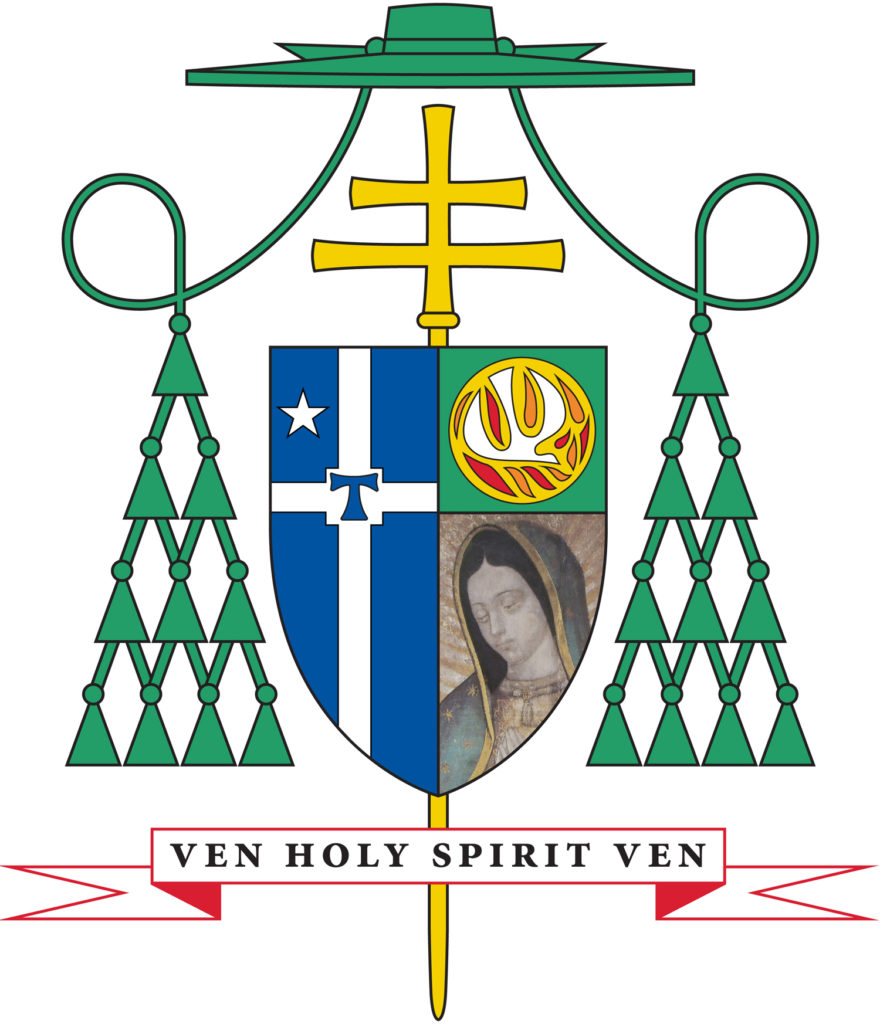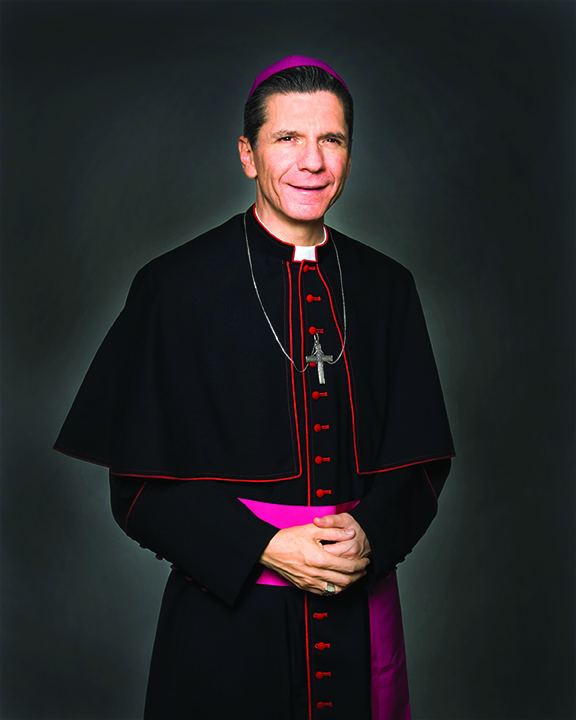Archbishop Gustavo García-Siller, MSpS

Coat of Arms
THE SHIELD
The Coat of Arms on the viewers’ right panel symbolizes the main thrust of the archbishop’s ministry. The upper image of the Holy Spirit surrounded by flames and encased in a green background symbolizes Christ’s creative power through the Spirit that saved Chicago (the archbishop’s first Episcopal ministry) from annihilation during the great fires of 1871. Christ’s love is the hope of the world (green background) as the gifts of the Spirit are at work transforming the world through the work of evangelization. The Holy Spirit is an agent of the Missionary discipleship work of love. The lower symbol is the icon of Our Lady of Guadalupe, who is the lodestar of the first and new evangelization and the beloved Mother of America. Her eyes look upon the Archdiocese of San Antonio with all her love, compassion and protection, bringing everyone together into one family, through listening, dialogue, and inclusion of all her children, especially the poor.
THE MOTTO
The Episcopal motto at the bottom, expressed in both Spanish and English, translates as “Come, Holy Spirit, Come.” It symbolizes the diversity of languages that express the one message of Christ: the dynamic love of God that transforms the world and harmonizes differences into a beautiful unity that only the Holy Spirit can create.

Archbishop Gustavo García-Siller was named Archbishop of San Antonio by Pope Benedict XVI on October 14, 2010. Installed as Archbishop on November 23, 2010, at St. Mark the Evangelist Church in San Antonio, TX, he succeeded Archbishop Jose H. Gomez as the 6th Archbishop of San Antonio.
He was appointed an auxiliary bishop of the Chicago Archdiocese on January 24, 2003, by Pope John Paul II, and ordained on March 19, 2003, by Archbishop of Chicago, Francis Cardinal George, O.M.I.
Born December 21, 1956, in San Luis Potosi S.L.P, Mexico to Gustavo García Suarez and Maria Cristina Siller de García, Archbishop García-Siller was the eldest of 15 children. He grew up sweeping floors, washing windows among other responsibilities in the family furniture store until he was 16 years old. He attended Colegio Motolinia Elementary School and graduated from Colegio Motolinia High School In San Luis Potosi. The archbishop received his Formator Certificate from Escuela de Verano Para Formadores. He earned a Masters degree in Theology and Divinity from St. John’s Seminary in Camarillo, California and received his Masters in Philosophy from Instituto de Filosofia, Guadalajara, Mexico. The archbishop attended ITESO, a Jesuit University in Guadalajara, Mexico, where he earned his Masters in Psychology.
In 1975 Archbishop García-Siller professed as a member of the Missionaries of the Holy Spirit. He was sent to the United States by his order in 1980, where he worked closely with the immigrant community. He was ordained a priest on June 22, 1984, in Guadalajara, Mexico. He became a citizen of the United States on December 15, 1998. His more than 26 years of priestly service has taken many forms, including ministering to communities with varied cultural backgrounds.
While in California he served in Fresno and at three parishes in the Los Angeles area. He also worked in Oregon for three years. Through those many years, he gave Parish Missions to Catholic parish communities throughout the United States.
Much of the archbishop’s work with his order involved the formation of the men of his religious order. From 1978 to 1980 he taught at INUMYC Minor Seminary in Guadalajara, Mexico and at the Institute for Philosophy in Guadalajara. He served as a formator and teacher at Institute of Philosophy in Guadalajara, Mexico from 1988 to 1990. He also was Rector of the Missionaries of the Holy Spirit in Lynwood and Long Beach California (1990 – 1996) and held that same position at Mount Angel in Mount Oregon (1996-1999).
Archbishop García-Siller has held several leadership positions in his religious order. From 1999 to 2003 he served as Major Superior of the Missionaries of the Holy Spirit, administering an area that at that time included the United States and Canada. He was elected the order’s Provincial in 2003.
He was named auxiliary bishop. In his new role, he served as Cardinal Francis George’s liaison to the Hispanic community and was assigned to Vicariate V, which covers the south side of Chicago and its southwest suburbs. This area includes 79 culturally diverse parishes.
On a national level, Archbishop García-Siller currently serves on a number of committees for the United States Conference of Catholic Bishops (USCCB): The Cultural Diversity Committee on Hispanic Affairs, African American Affairs, Committee on Hispanics and the Liturgy, the Committee on Migration (USCCB), and served as Chair of Region 7 of the USCCB, which includes Illinois, Wisconsin and Indiana. He also served on the Committee on Consecrated Life.
The upper image of the Holy Spirit surrounded by flames and encased in a green background symbolizes Christ’s creative power through the Spirit that saved Chicago (the archbishop’s first Episcopal ministry) from annihilation during the great fires of 1871. Christ’s love is the hope of the world (green background) as the gifts of the Spirit are at work transforming the world through the work of evangelization. The Holy Spirit is an agent of the Missionary discipleship work of love.
The lower symbol is the icon of Our Lady of Guadalupe, who is the lodestar of the first and new evangelization and the beloved Mother of America. Her eyes look upon the Archdiocese of San Antonio with all her love, compassion and protection, bringing everyone together into one family, through listening, dialogue, and the inclusion of all her children, especially the poor.
The Episcopal motto at the bottom, expressed in both Spanish and English, translates as “Come, Holy Spirit, Come.” It symbolizes the diversity of languages that express the one message of Christ: the dynamic love of God that transforms the world and harmonizes differences into a beautiful unity that only the Holy Spirit can create.
The Coat of Arms on the viewers’ left panel is the insignia of the Archdiocese of San Antonio showing the large cross of Christian faith with its center enlarged and squared to receive the cross peculiar to St. Anthony, called by heralds the TAU cross because of its resemblance to the Greek letter of that name. It is derived from the short crutch that the saint slipped under one arm to support his tired body during long vigils. Above is the “Lone Star” of the State of Texas in the vast blue sky.
The Episcopal shield is completed with external ornaments consisting of a gold processional cross, placed in the back of the shield and extending above and below it; a pontifical hat, called a gallero; and four rows of green tassels on either side of the shield: Baptism, Confirmation, Priesthood, Episcopory, and Archbishop. These are the heraldic insignia of a prelate of the rank of archbishop by the instruction of The Holy See on March 31, 1969; the call to serve holding nothing back.
Gustavo García-Siller fue nombrado Arzobispo de San Antonio por el Papa Benedicto XVI el 14 de octubre del 2010. Fue instalado como arzobispo el 23 de noviembre del 2010 en la parroquia San Marcos el Evangelista de San Antonio, Texas, él le procedió como el sexto Arzobispo de San Antonio al Arzobispo José H. Gómez.
Fue nombrado obispo auxiliar de la Arquidiócesis de Chicago el 24 de enero del 2003 por el Papa Juan Pablo II, y fue ordenado el 19 de marzo de 2003 por el Arzobispo de Chicago, Francisco Cardenal George, O.M.I. Nacido el 21 de diciembre del 1956 en San Luis Potosí SLP, México a Gustavo García Suárez y María Cristina Siller de García, el arzobispo García-Siller fue el mayor de 15 hijos. Creció barriendo pisos, lavando ventanas, entre otras responsabilidades, en la tienda de muebles de la familia hasta que tuvo 16 años. Asistió a, y se graduó de la Escuela Primaria y la Escuela Secundaria del Colegio Motolinía, en San Luis Potosí.
El arzobispo recibió su Certificado de Formador de la Escuela de Verano de Para Formadores. Obtuvo una Maestría en Teología y Divinidad del Seminario de San Juan en Camarillo en California y recibió su Maestría en Filosofía del Instituto de Filosofía de Guadalajara, México. El arzobispo asistió a ITESO, una Universidad Jesuita en Guadalajara México, donde obtuvo su Maestría
en Psicología.
En 1975 el arzobispo García-Siller profesó como miembro de los Misioneros del Espíritu Santo. Fue enviado a los Estados Unidos por su orden en el 1980, donde trabajó en cercanía y en colaboración con la comunidad inmigrante. Se ordenó sacerdote el 22 de junio del 1984 en Guadalajara, México. Obtuvo su ciudadanía Americana el 15 de diciembre del 1998. Sus 26 años de servicio sacerdotal ha tomado muchas formas, incluyendo ministrando a las comunidades con variedades de intereses culturales. Mientras que en California él ministró en Fresno y en tres parroquias en la área de Los Ángeles. También trabajó en Oregón durante tres años. A través de los muchos años, él ha hablado en muchas Misiones en las comunidades parroquiales católicas en los Estados Unidos.
Una gran parte del trabajo del arzobispo envolvía la formación de los miembros de su orden religiosa. Desde el año 1978 hasta el 1980, enseñó en el Seminario Menor INUMYC en Guadalajara México, y en el Instituto de Filosofía en Guadalajara. Se desempeñó como formador y profesor en el Instituto de Filosofía en Guadalajara, México a partir de 1988 hasta el 1990. También fue rector de los Misioneros del Espíritu Santo en Lynwood y Long Beach California (1990 – 1996) y mantuvo esta misma posición en Mount Ángel en Oregón (1996-1999).
El Arzobispo García-Siller ha ocupado varios puestos de liderazgo en su orden religiosa. Desde el 1999 al 2003, ocupó el cargo de Superior Mayor de los Misioneros del Espíritu Santo, administrando un área que en ese tiempo incluía a los Estados Unidos y Canadá. Fue elegido Provincial de la orden en el 2003. Fue nombrado obispo auxiliar. En su nuevo cargo, el desempeñó el rol de enlace para el Cardenal Francis George y la comunidad hispana, y fue asignado a Vicariato V de la Arquidiócesis de Chicago, el cubre el sur de la cuidad y sus suburbios del sudoeste. Esta zona incluye 79 parroquias culturalmente diversas.
A nivel nacional, el Arzobispo García-Siller ha participado en una serie de comités para la Conferencia de Obispos Católicos Estadounidense (USCCB): El Comité de Diversidad Cultural en Asuntos Hispanos, Asuntos Afroamericanos, Comité sobre los hispanos y la Liturgia, el Comité sobre Migración (USCCB), y se desempeñó el rol como Presidente de la Región 7 de la USCCB, que incluye a Illinois, Wisconsin y a Indiana. También sirvió en el Comité de Vida Consagrada. Él es parte del Subcomité de Obispos para los Hispanos y la Liturgia y del Comité de Justicia Nacional y Desarrollo Humano.
Recent News
Catholic Charities and archbishop distribute Thanksgiving turkey boxes
Today’s Catholic Newspaper
Comments Off on Catholic Charities and archbishop distribute Thanksgiving turkey boxes
The Children’s Hospital of San Antonio hosts Christmas tree lighting
Today’s Catholic Newspaper
Comments Off on The Children’s Hospital of San Antonio hosts Christmas tree lighting
Mission’s secret shortcut revealed
Today’s Catholic Newspaper
Comments Off on Mission’s secret shortcut revealed
Catholic Charities partners to distribute Boxes of Blessings
Today’s Catholic Newspaper
Comments Off on Catholic Charities partners to distribute Boxes of Blessings
Buddy and Lisa Valastro visit pediatric patients and families
Today’s Catholic Newspaper
Comments Off on Buddy and Lisa Valastro visit pediatric patients and families
Catholic Charities celebrates serving community through selfless service
Today’s Catholic Newspaper
Comments Off on Catholic Charities celebrates serving community through selfless service

